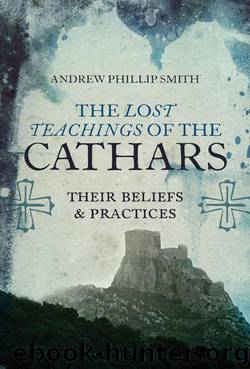Lost Teachings of the Cathars by Andrew Phillip Smith

Author:Andrew Phillip Smith
Language: eng
Format: azw3, epub
Tags: The Lost Teachings of the Cathars
ISBN: 9781780287157
Publisher: Watkins Media
Published: 2015-11-24T05:00:00+00:00
Chapter 10
Secret Origins
How did an essentially Gnostic movement come to exist in western Europe, in the south of France, northern Italy, the Rhine valley, territories that were neither isolated nor marginal but near the heartlands of Roman Catholic Christendom in the high Middle Ages? Surely it was spiritual hunger and a widespread anti-clericalism that nurtured the seed of Catharism, but how was it planted in the first place? Where did Catharism come from? How did it get there? How old was it by the time Bernard of Clairvaux launched his spiritual fight against it?
The Cathars themselves had a straightforward solution to the question of their origins. They said that they were the Good Christians, the good Men and Women, and that the laying on of hands in the consolamentum from Perfect to Perfect stretched, hand to shoulder, all the way back to Christ. Walter Map, English collector of curiosities, agreed with them and said that the Cathars (though perhaps he meant heretics in general) had been lurking around all that time, ‘Everywhere among Christians they have lain hidden since the time of the Lord’s Passion, straying in error.’1
There are no real hints that the consolamentum was an ancient practice preserved since the 1st or 2nd century, but there is every possibility of a genuine chain of transmission, though the links may be tenuous and corroded, from the ancient Gnostics to the medieval Cathars. After all, the Cathars’ claim to a continuous succession of influence from the apostles onwards isn’t unique. The Catholic Church itself claims an unbroken line of apostolic succession from Jesus to Peter through the successive bishops on to the present time.
The naive notion that the Cathar Church went all the way back to the time of Jesus must be dismissed immediately. However, it is quite possible that the Cathars may be traced back to the 2nd or 3rd century via movements that had a direct linkage through time and which shared some of the same concepts – ones that were at odds with the exoteric transmission of Catholic Christianity. But it is not feasible that there were Cathars at the beginning of Christianity, despite the Cathars’ own mythic origins as successors of Christ.
Yet neither can the opposite pole of opinion be true, that they emerged as Catholic heretics in the Middle Ages. Salvo Burci believed that the heretics were originally members of the Roman Church by baptism and therefore Catholics who had gone ‘bad’. This may have been true for many of the Italian Cathars who existed when he was writing, in around 1235, because the Cathars were expanding their numbers rapidly and new converts would by definition have been people brought up as Catholics. But the idea that Cathars in general originated when medieval Catholics ‘went wrong’ is unrealistic, though conventional.2
To this must be added the view that has emerged among some modern scholars, such as Mark Gregory Pegg, that there never really were any Cathars.3 Pegg believes that the Cathars only became a coherent movement in response to the action of the Church, the Albigensian Crusade, and so on.
Download
Lost Teachings of the Cathars by Andrew Phillip Smith.epub
This site does not store any files on its server. We only index and link to content provided by other sites. Please contact the content providers to delete copyright contents if any and email us, we'll remove relevant links or contents immediately.
The Hatha Yoga Pradipika (Translated) by Svatmarama(2487)
Real Sex by Lauren F. Winner(2477)
The Holy Spirit by Billy Graham(2419)
The Secret Power of Speaking God's Word by Joyce Meyer(2254)
The Gnostic Gospels by Pagels Elaine(2027)
Devil, The by Almond Philip C(1901)
23:27 by H. L. Roberts(1894)
Jesus by Paul Johnson(1889)
The Nativity by Geza Vermes(1851)
All Things New by John Eldredge(1783)
Chosen by God by R. C. Sproul(1763)
Angels of God: The Bible, the Church and the Heavenly Hosts by Mike Aquilina(1628)
The Return of the Gods by Erich von Daniken(1573)
Angels by Billy Graham(1552)
Evidence of the Afterlife by Jeffrey Long(1460)
Knowing God by J.I. Packer(1433)
The Gnostic Gospel of St. Thomas by Tau Malachi(1414)
Victorian Sensation by James A. Secord(1408)
How To Be Born Again by Billy Graham(1405)
